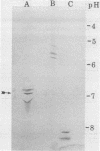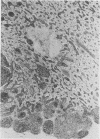Abstract
Artificial infection chambers in rabbits were infected with a toxic shock strain of Staphylococcus aureus in an attempt to determine the nature of the enhanced virulence of toxic shock strains relative to non-toxic shock strains of staphylococci. The results showed that rabbits immunized with either neutral or acidic proteins were protected from the lethal effects of these infections. Male rabbits were found to be significantly more susceptible to these infections than female rabbits. Castration rendered both sexes equally susceptible to lethal infections. Numerous tissues from all infected rabbits were examined histologically, and most of the pathological findings involved lymphoid tissue. Of special interest was the observation that unprotected male rabbits which died had evidence of lymphoid depletion and that surviving rabbits, both male and female, usually manifested lymphoid hyperplasia. No other pathological response was noted which would characterize these infections, but immunized rabbits had a diminished level of thymic cortex involution that was not different between the sexes.
Full text
PDF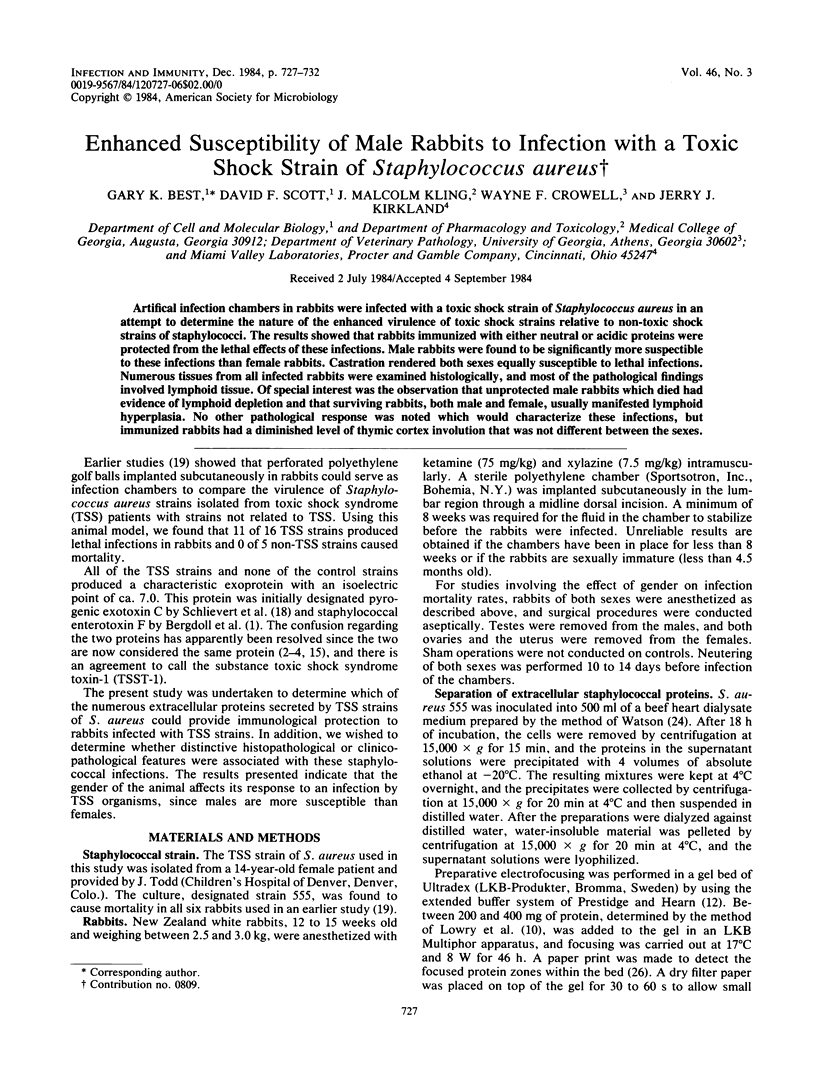
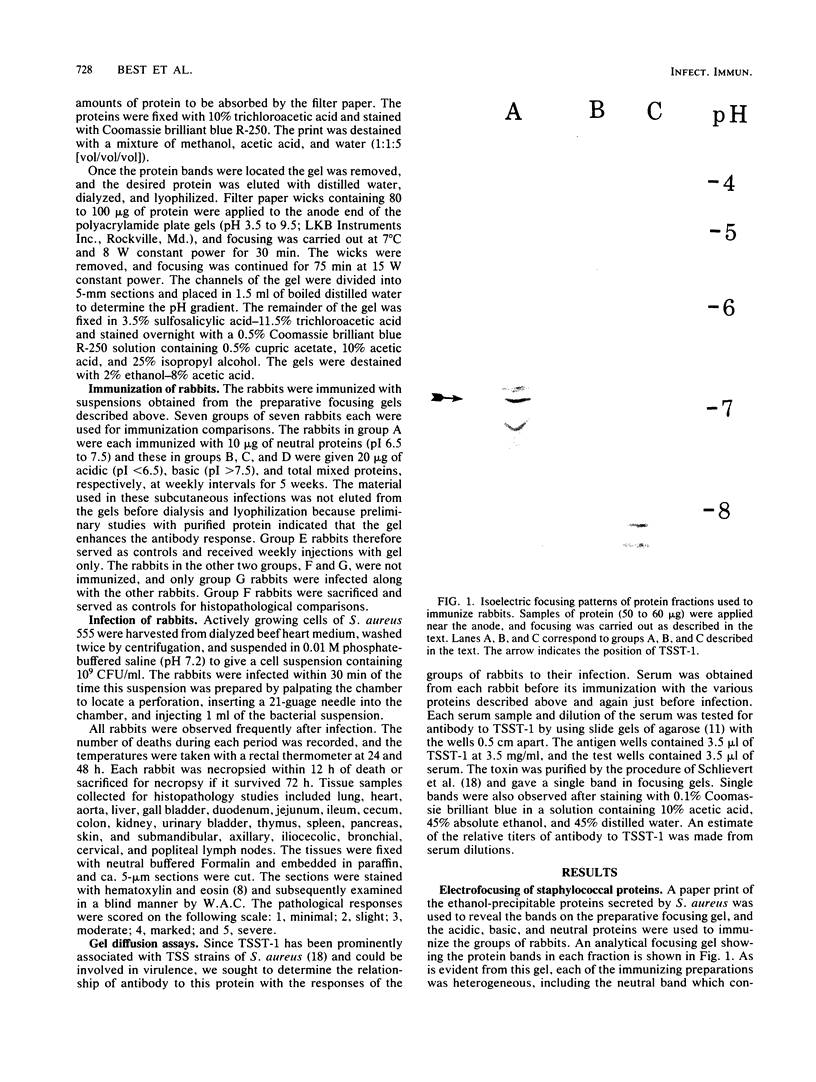
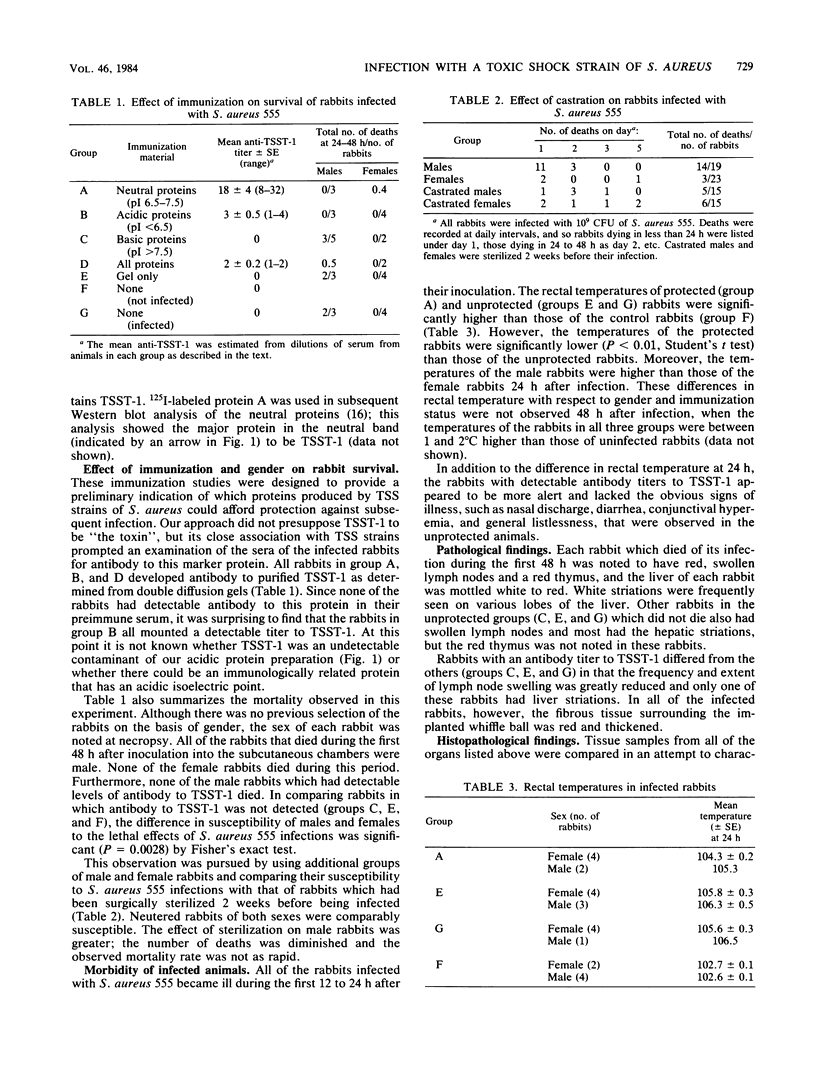
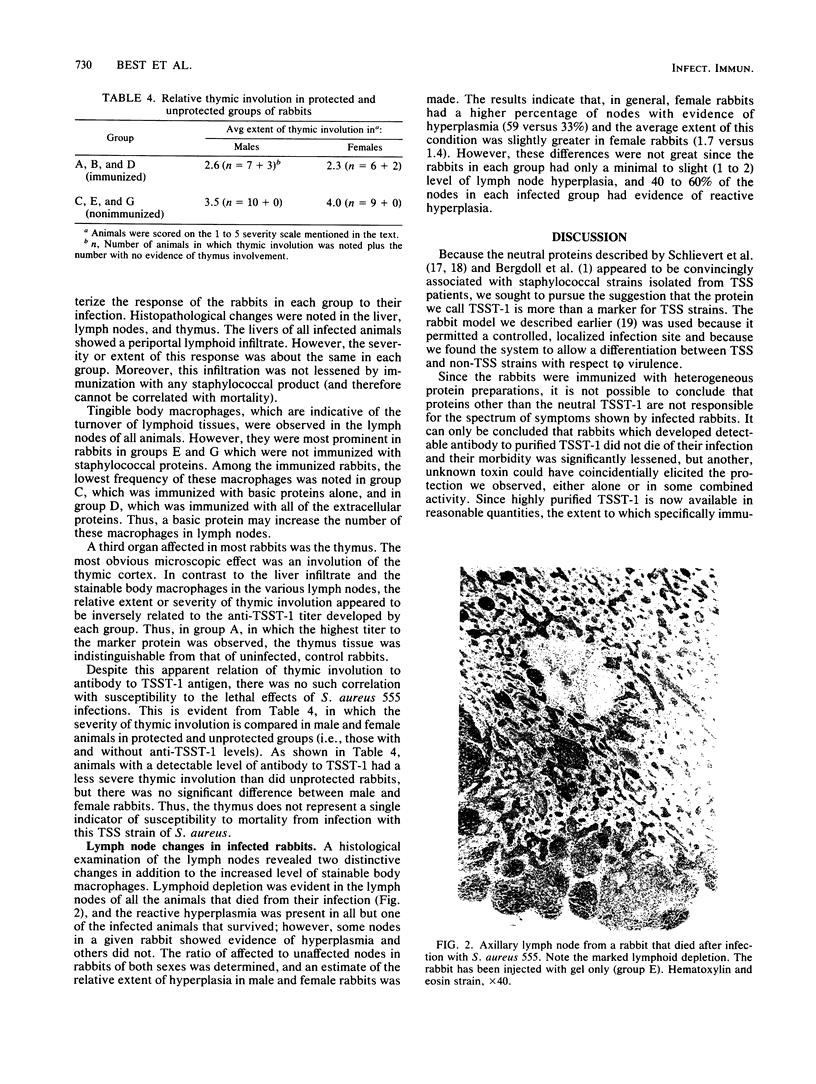
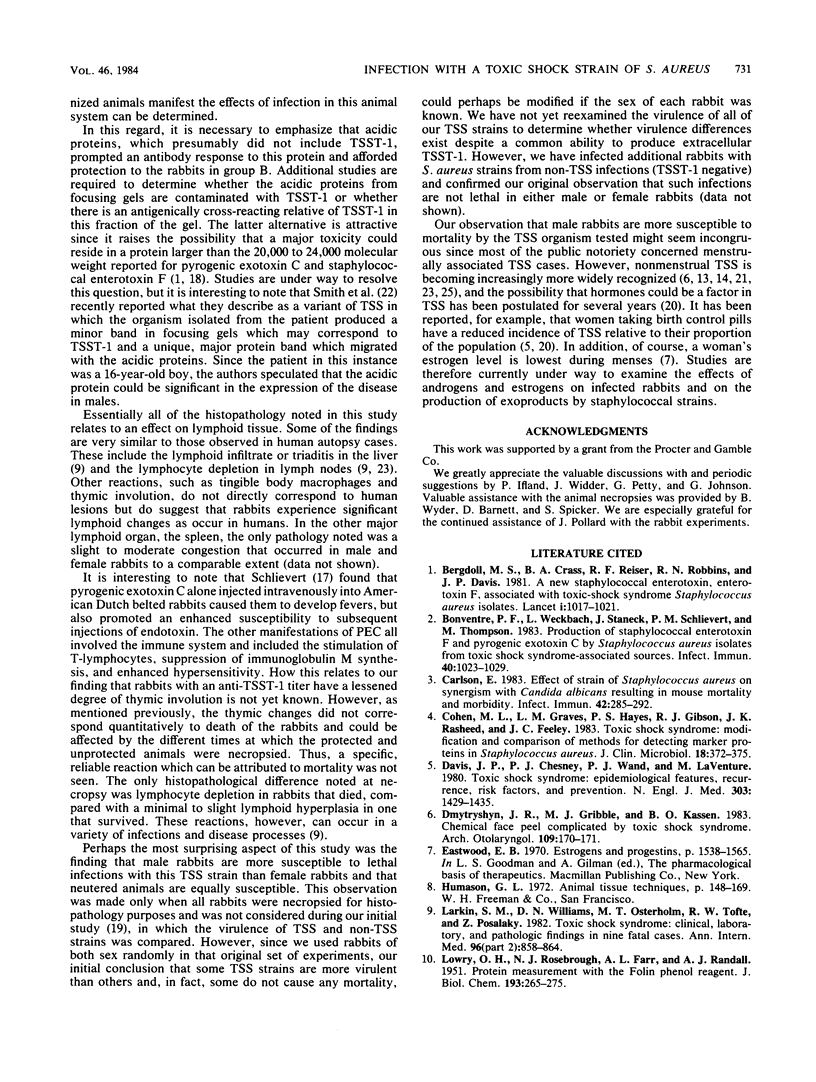
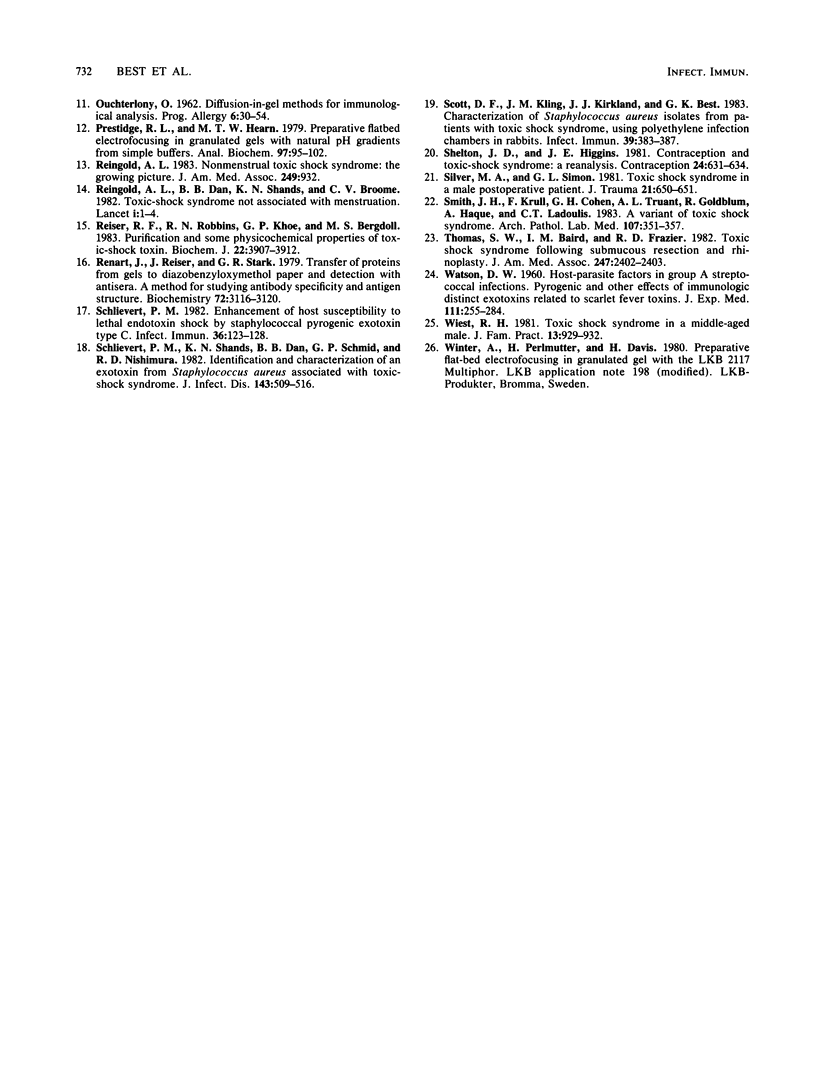
Images in this article
Selected References
These references are in PubMed. This may not be the complete list of references from this article.
- Bergdoll M. S., Crass B. A., Reiser R. F., Robbins R. N., Davis J. P. A new staphylococcal enterotoxin, enterotoxin F, associated with toxic-shock-syndrome Staphylococcus aureus isolates. Lancet. 1981 May 9;1(8228):1017–1021. doi: 10.1016/s0140-6736(81)92186-3. [DOI] [PubMed] [Google Scholar]
- Bonventre P. F., Weckbach L., Staneck J., Schlievert P. M., Thompson M. Production of staphylococcal enterotoxin F and pyrogenic exotoxin C by Staphylococcus aureus isolates from toxic shock syndrome-associated sources. Infect Immun. 1983 Jun;40(3):1023–1029. doi: 10.1128/iai.40.3.1023-1029.1983. [DOI] [PMC free article] [PubMed] [Google Scholar]
- Carlson E. Effect of strain of Staphylococcus aureus on synergism with Candida albicans resulting in mouse mortality and morbidity. Infect Immun. 1983 Oct;42(1):285–292. doi: 10.1128/iai.42.1.285-292.1983. [DOI] [PMC free article] [PubMed] [Google Scholar]
- Cohen M. L., Graves L. M., Hayes P. S., Gibson R. J., Rasheed J. K., Feeley J. C. Toxic shock syndrome: modification and comparison of methods for detecting marker proteins in Staphylococcus aureus. J Clin Microbiol. 1983 Aug;18(2):372–375. doi: 10.1128/jcm.18.2.372-375.1983. [DOI] [PMC free article] [PubMed] [Google Scholar]
- Davis J. P., Chesney P. J., Wand P. J., LaVenture M. Toxic-shock syndrome: epidemiologic features, recurrence, risk factors, and prevention. N Engl J Med. 1980 Dec 18;303(25):1429–1435. doi: 10.1056/NEJM198012183032501. [DOI] [PubMed] [Google Scholar]
- Dmytryshyn J. R., Gribble M. J., Kassen B. O. Chemical face peel complicated by toxic shock syndrome. A case report. Arch Otolaryngol. 1983 Mar;109(3):170–171. doi: 10.1001/archotol.1983.00800170036009. [DOI] [PubMed] [Google Scholar]
- LOWRY O. H., ROSEBROUGH N. J., FARR A. L., RANDALL R. J. Protein measurement with the Folin phenol reagent. J Biol Chem. 1951 Nov;193(1):265–275. [PubMed] [Google Scholar]
- Larkin S. M., Williams D. N., Osterholm M. T., Tofte R. W., Posalaky Z. Toxic shock syndrome: clinical, laboratory, and pathologic findings in nine fatal cases. Ann Intern Med. 1982 Jun;96(6 Pt 2):858–864. doi: 10.7326/0003-4819-96-6-858. [DOI] [PubMed] [Google Scholar]
- OUCHTERLONY O. Diffusion-in-gel methods for immunological analysis. II. Prog Allergy. 1962;6:30–154. doi: 10.1159/000313795. [DOI] [PubMed] [Google Scholar]
- Prestidge R. L., Hearn M. T. Preparative flatbed electrofocusing in granulated gels with natural pH gradients generated from simple buffers. Anal Biochem. 1979 Aug;97(1):95–102. doi: 10.1016/0003-2697(79)90332-4. [DOI] [PubMed] [Google Scholar]
- Reingold A. L., Dan B. B., Shands K. N., Broome C. V. Toxic-shock syndrome not associated with menstruation. A review of 54 cases. Lancet. 1982 Jan 2;1(8262):1–4. doi: 10.1016/s0140-6736(82)92552-1. [DOI] [PubMed] [Google Scholar]
- Reingold A. L. Nonmenstrual toxic shock syndrome: the growing picture. JAMA. 1983 Feb 18;249(7):932–932. [PubMed] [Google Scholar]
- Reiser R. F., Robbins R. N., Khoe G. P., Bergdoll M. S. Purification and some physicochemical properties of toxic-shock toxin. Biochemistry. 1983 Aug 2;22(16):3907–3912. doi: 10.1021/bi00285a028. [DOI] [PubMed] [Google Scholar]
- Renart J., Reiser J., Stark G. R. Transfer of proteins from gels to diazobenzyloxymethyl-paper and detection with antisera: a method for studying antibody specificity and antigen structure. Proc Natl Acad Sci U S A. 1979 Jul;76(7):3116–3120. doi: 10.1073/pnas.76.7.3116. [DOI] [PMC free article] [PubMed] [Google Scholar]
- Schlievert P. M. Enhancement of host susceptibility to lethal endotoxin shock by staphylococcal pyrogenic exotoxin type C. Infect Immun. 1982 Apr;36(1):123–128. doi: 10.1128/iai.36.1.123-128.1982. [DOI] [PMC free article] [PubMed] [Google Scholar]
- Schlievert P. M., Shands K. N., Dan B. B., Schmid G. P., Nishimura R. D. Identification and characterization of an exotoxin from Staphylococcus aureus associated with toxic-shock syndrome. J Infect Dis. 1981 Apr;143(4):509–516. doi: 10.1093/infdis/143.4.509. [DOI] [PubMed] [Google Scholar]
- Scott D. F., Kling J. M., Kirkland J. J., Best G. K. Characterization of Staphylococcus aureus isolates from patients with toxic shock syndrome, using polyethylene infection chambers in rabbits. Infect Immun. 1983 Jan;39(1):383–387. doi: 10.1128/iai.39.1.383-387.1983. [DOI] [PMC free article] [PubMed] [Google Scholar]
- Shelton J. D., Higgins J. E. Contraception and toxic-shock syndrome: a reanalysis. Contraception. 1981 Dec;24(6):631–634. doi: 10.1016/0010-7824(81)90014-7. [DOI] [PubMed] [Google Scholar]
- Silver M. A., Simon G. L. Toxic shock syndrome in a male postoperative patient. J Trauma. 1981 Aug;21(8):650–651. doi: 10.1097/00005373-198108000-00009. [DOI] [PubMed] [Google Scholar]
- Smith J. H., Krull F., Cohen G. H., Truant A. L., Goldblum R., Haque A., Ladoulis C. T. A variant of toxic shock syndrome. Clinical, microbiologic, and autopsy findings in a fatal case. Arch Pathol Lab Med. 1983 Jul;107(7):351–357. [PubMed] [Google Scholar]
- Thomas S. W., Baird I. M., Frazier R. D. Toxic shock syndrome following submucous resection and rhinoplasty. JAMA. 1982 May 7;247(17):2402–2403. [PubMed] [Google Scholar]
- WATSON D. W. Host-parasite factors in group A streptococcal infections. Pyrogenic and other effects of immunologic distinct exotoxins related to scarlet fever toxins. J Exp Med. 1960 Feb 1;111:255–284. doi: 10.1084/jem.111.2.255. [DOI] [PMC free article] [PubMed] [Google Scholar]
- Wiest R. H. Toxic shock syndrome in a middle-aged male. J Fam Pract. 1981 Nov;13(6):929–932. [PubMed] [Google Scholar]



